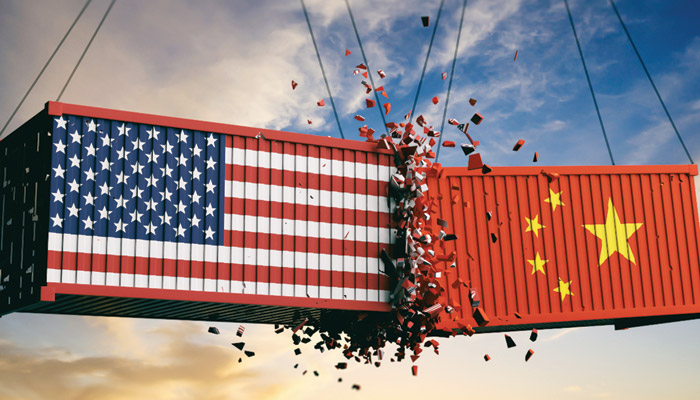On July 6, 2018, 25 per cent border tax was imposed by the US on $34 bn worth of Chinese goods being imported into the US. China responded to this policy with a 25 per cent tariff on $34 bn worth US goods like soybeans, cotton linters, uncombed cotton, lobsters, and automobiles.
The intent behind the US imposing 25 per cent trade tax on Chinese products like flat-screen televisions, medical devices, and aircraft parts, etc. was to punish China for its controversial trade policies, by making their products expensive for American consumers, pushing them to seek similar products elsewhere. China has been accused by the US, of forcing foreign businesses to handover their technological might to Chinese companies in exchange for market access in China and indulges in cyber theft to acquire trade secrets. In turn, China has accused the US of starting the biggest trade war in the economic history.
This is just the beginning of the trade war, though. These are the initial round of tariffs imposed by both giants. The US is expected to impose these border taxes on additional $16 bn worth Chinese goods, followed by tariffs (10 per cent) on another $200 bn worth Chinese goods, including cotton, cotton yarn, cotton linters and pulp, cotton waste, cotton sewing threads and cotton woven fabric, amongst others. The US in this bid is targeting high-tech Chinese goods which are bound to put pressure on Beijing’s “Made in China 2025” programme targets. Whereas, China is focusing its tariffs on agricultural exports from the US which are due to affect the current Trump government’s prospects in the 2018 midterm elections. The US has justified its actions as a step towards bringing manufacturing and jobs back to the US and reducing their trade deficits.
Immediate results of the Trade War
This move has surely resulted in initial, substantial fall in Asian markets. Owing to Trump’s ‘America First’ trade strategy, the US is threatening heavy tariffs on many of its major trading partners including China, the EU, Mexico, and Canada.
Did You Know: Rick Helfenbein, (President, American Apparel & Footwear Association) has called America’s move as “hollow, vindictive and reckless” as it can endanger the $130 bn in American exports to China.
This move is also expected to affect the middleclass American citizens, as China imports around $200 bn of US goods only, whereas America’s dependence on Chinese goods is huge, and fulfilling the gap created by these tariff will not only increase the prices within the American market substantially is also going to be tough for American industry to match the demands.
How is it going to affect the rest of the world?
Companies with global supply chains are surely biting their nails. The trade war is going to create barriers to free international trade, which can be detrimental to the movement of their goods. Also, the costs of basic products like smartphones, other electronics, toys, and clothes are expected to go up.
When superpowers argue, the entire world feels the heat. And this action of the American Government has surely sent shivers down the global financial markets. Moreover, as the supply chains around the world start contracting, the cost for everyday goods will go up for global consumers also.
Effects of the trade war on apparel industry
41 per cent of US’s apparel consumption, 72 per cent of America’s footwear consumption and 84 per cent of travel goods sold in the US, are made in China. This makes the US consumer highly vulnerable to the trade war.
The US is the traditional export market for China’s textile and apparel production. Although China has substantial penetration in the EU, ASEAN and Japanese markets as well, 17 per cent of China’s textile and apparel exports go to the US. China’s imports, on the other hand, from the US makes up for only 3 per cent of its total imports in this segment. If we look at the US market, 48.9 per cent of apparel and textile imported by the US in 2017 was from China.
So, if we look at the comprehensive picture here, US accounts for 17 per cent of China’s textile and apparel exports, while China accounts for nearly 50 per cent of the US. This clearly highlights that the US has a much higher import dependency on China, in this sector. This trade war has also given an opportunity to China’s Asian competitors like India, Bangladesh, Vietnam, Cambodia, and Pakistan to pick up their respective market shares in the US market. Some African countries like Ethiopia also have the chance to show their strength as growing suppliers to the US market. Both the US and China are imposing tariffs on cotton. The impact of this move is going to have a wider macroeconomic impact on the industry.
China’s domestic cotton demands are growing, and so are China’s cotton imports. Cotton Incorporated senior economist Jon Devine has said,“ China traditionally has a production deficit between 10-15 mn bales. That deficit had been filled by reserves in recent years, but with reserves now lower, that gap should be increasingly filled by imports.” While the US is the world’s largest cotton exporter, followed by India. This tariff war hence will have direct implications on China’s raw material costs, and hence its finished product costs. But, this will also open India’s avenues of gaining more market share in China’s cotton imports.
Did You Know: It will take India with the next six largest cotton exporters to equal the volume of cotton exported by the US.
There are although several categories for cotton imports in China, and varying levels of tariffs will have a complex impact on the cotton process. But it is evident that the prices will go upward. But what is more challenging for the global players in this scenario is the uncertainty this trade war brings regarding the cotton prices in the long term.
Did You Know: Leading US apparel retailers like Gap, Levi Strauss Target Corp, and VF Corporation, have signed a letter, urging President Trump to avoid any trade war with China.
A US Fashion Industry Association’s benchmark study claims that to make the industry more globalized and fast-paced, it is important for businesses to maintain a balance between their sourcing costs, speed, flexibility, reliability, and risks. To strike this balance, most companies in the industry are diversifying their sourcing base. Such trade wars put in more meaning to these diversification efforts. Being said that, almost all apparel businesses globally are more or less source from China. Hence, cost fluctuations due to the trade ware after effects will affect the global apparel and textile industry substantially. Moreover, consumers around the globe should get ready to face higher apparel costs as a result of the two giants facing each other off in this trade war



















